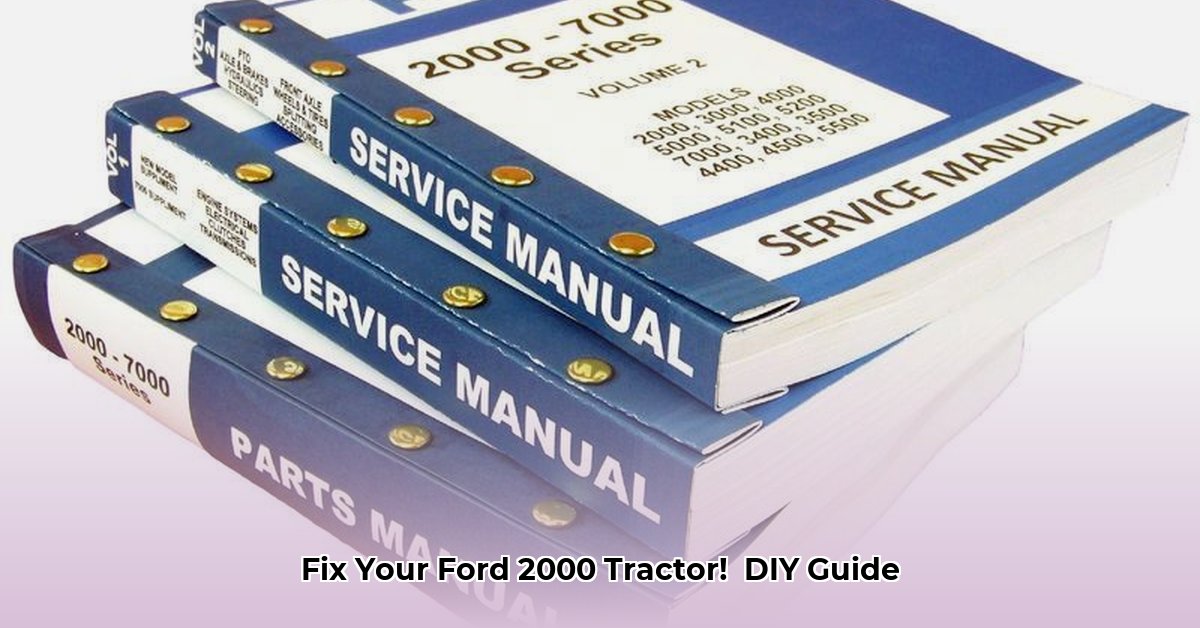
Understanding Your Ford 2000 Tractor Manuals: A DIY Repair Guide
Owning a Ford 2000 tractor is a testament to appreciating reliable machinery. But even the sturdiest equipment needs occasional repairs. This guide empowers you to tackle those repairs yourself, saving money and gaining valuable mechanical skills using readily available Ford 2000 tractor parts manuals in PDF format. We'll walk you through using both the repair and parts manuals effectively. This isn't just about reading PDFs; it's about mastering your tractor's inner workings. For additional resources, check out this helpful website.
The Two Essential Manuals: Repair and Parts
Before starting any repair, you need two essential resources: the repair manual and the parts manual (both ideally in digital PDF format). Think of them as a dynamic duo—one guides the repair process, while the other helps you source the correct replacements.
The repair manual acts as your step-by-step instructor, guiding you through troubleshooting and repair procedures with detailed instructions and helpful diagrams. The parts manual, on the other hand, functions as a comprehensive parts catalog. It provides visual representations of every component, complete with corresponding part numbers for easy ordering. Finding digital versions online is feasible, though older manuals might lack information on newer components. Always verify part availability with a reputable supplier. Let's explore how to use them.
Mastering the Repair Manual: Step-by-Step Guidance
This section provides a structured approach to using your Ford 2000 tractor repair manual. Did you know that a clear understanding of the manual can reduce repair time by up to 30%?
Identify Your Tractor Model: Begin by locating your tractor's model number and serial number. This critical information is crucial for accessing the precise repair procedures within your manual. It's usually found on a sticker attached to the tractor itself.
Pinpoint the Problem: Clearly identify the issue with your tractor. Are you dealing with a faulty engine component? Hydraulic problems? The more detailed your description, the easier it will be to locate relevant information in the manual.
Navigate the Manual: Efficiently utilize the index and table of contents to locate the section addressing your specific problem. This prevents unnecessary searching.
Diagram Mastery: Ford 2000 tractor repair manuals rely heavily on diagrams. Take your time to thoroughly understand each diagram, paying close attention to the labels and annotations. These are visual clues to successful repair.
Meticulous Procedure: Follow the repair instructions step-by-step. Each step is crucial, and deviating from the sequence can result in further complications.
Specifications and Torque: Be attentive to specifications and torque values (the measurement of rotational force). Incorrect tightening can cause considerable damage. The manual provides these essential details.
Efficient Parts Ordering with the Parts Manual
Now that you've understood the repair process, the next stage involves procuring the necessary components. Using the parts manual correctly can save you both time and money on parts.
Part Identification: Use the diagrams to identify the needed component. Each part has a unique number—note it down carefully.
Cross-referencing: If you encounter difficulties locating a specific part, don't hesitate to cross-reference the information within the manual. It’s possible the part may be listed under an alternate category.
Online Ordering: Once you have the part numbers, conducting thorough online research is recommended. Numerous agricultural supply stores offer online parts ordering, allowing you to compare prices and availability before making a purchase.
Troubleshooting and Common Challenges
Even with the best manuals, you might encounter challenges.
Obsolete Parts: Older tractors might demand parts no longer in production. Consider exploration of online forums and communities dedicated to Ford tractors. They are treasure troves of solutions and innovative substitutes.
Inaccurate Information: While rare, errors can creep into manuals. If something seems amiss, cross-reference the information with other credible sources to verify accuracy.
Safety First: Essential Precautions
Working with machinery carries inherent risks. Prioritize safety above all else.
Power Disconnection: Always disconnect the power source before commencing any repair work.
Protective Gear: Wear gloves, eye protection, and sturdy footwear at all times.
Collaborative Work: If possible, have a second person present for an additional layer of safety.
Awareness of Moving Parts: Remain vigilant about moving parts, especially during reassembly.
Conclusion: Empowering Your DIY Tractor Repair
Using Ford 2000 tractor parts manuals effectively transforms you from a tractor owner into a resourceful mechanic. By combining the instructions in the repair manual with the parts information in the parts manual, you gain confidence to tackle repairs, saving money and gaining invaluable experience. Remember, safety is paramount. Share your experiences in the comments below; let's build a community of skilled DIY tractor mechanics!